Punjab State Board PSEB 6th Class Science Book Solutions Chapter 15 Air Around Us Textbook Exercise Questions and Answers.
PSEB Solutions for Class 6 Science Chapter 15 Air Around Us
PSEB 6th Class Science Guide Air Around Us Textbook Questions and Answers
1. Fill in the Blanks:
(a) Plants give out ……………….. gas and breathe in ……………….. gas.
Answer:
oxygen, carbon dioxide
(b) …………………. gas can not be used directly from the atmosphere.
Answer:
nitrogen
(c) Earth is protected from the harmful rays of sun by …………………… layer.
Answer:
ozone
![]()
(d) ………………. is important for the water cycle.
Answer:
air.
2. Write True or False:
(a) Oxygen gas protects us from the harmful UV rays of the sun.
Answer:
Flase
(b) Carbondioxide is required for burning of fuel.
Answer:
Flase
(c) Composition of air always remain the same.
Answer:
Flase
(d) Air contains equal amount of oxygen and nitrogen.
Answer:
Flase
(e) Aquatic animals breathe carbon dioxide which is dissolved in water.
Answer:
Flase
3. Match the Column A with Column B:
| Column A | Column B |
| 1. Most abundant gas in the air | (a) ozone |
| 2. Gas required for photosynthesis | (b) water vapours |
| 3. Gas used for respiration | (c) carbondioxide |
| 4. Form of water present in the air | (d) nitrogen |
| 5. Layer that protects us from harmful rays of Sun | (e) oxygen |
Answer:
| Column A | Column B |
| 1. Most abundant gas in the air | (d) nitrogen |
| 2. Gas required for photosynthesis | (c) carbondioxide |
| 3. Gas used for respiration | (e) oxygen |
| 4. Form of water present in the air | (b) water vapour |
| 5. Layer that protects us from harmful rays of Sun | (a) ozone |
![]()
4. Choose the Correct Answer:
Question (i)
Air contains highest percentage of which gas ?
(a) Oxygen
(b) Nitrogen
(c) Smoke
(d) Carbondioxide.
Answer:
(b) Nitrogen
Question (ii)
Which gas is a supporter of combustion ?
(a) Nitrogen
(b) Carbondioxide
(c) Smoke
(d) Oxygen.
Answer:
(d) Oxygen
Question (iii)
Moving air is known as:
(a) Wind
(b) Water vapour
(c) Ozone
(d) Wind mill.
Answer:
(a) Wind
Question (iv)
Earthworms come out of soil during:
(a) heavy rains
(b) cold weather
(c) snow
(d) hot weather.
Answer:
(a) heavy rains.
5. Very Short Answer Type Questions:
Question (i)
Which gas is essential for breathing of animals ?
Answer:
Oxygen gas is essential for breathing of animals.
Question (ii)
Name one component of air that does not support burning.
Answer:
Carbon dioxide does not support burning.
Question (iii)
Name the components of air.
Answer:
Components of air are nitrogen, oxygen, carbon dioxide, water vapours, and smoke.
![]()
6. Short Answer Type Questions:
Question (i)
Which gas in the atmosphere is essential for respiration ?
Answer:
Oxygen gas is essential for respiration.
Question (ii)
Why does a lemp of cotton wool shrink in water ?
Answer:
A lemp of cotton has air trapped in it in the spaces between the cotton wool. When water is poured on it or lemp of cotton is dipped in water, the air so trapped gets displaced and appears in the form of bubbles with the result no air space is left between the glasswool. In this way, the size of the lemp decreases so that it shrinks.
Question (iii)
How will you show that air dissolves in water ?
Answer:
To show that air dissolves in water, we can perform the following experiment.
Steps of the Procedure.
- Take some water in glass vessel and heat it on a tripod stand before it begins to boil.
- Look at the inner surface of vessel.
- The tiny bubbles appear inside before water starts boiling.
- These are air bubbles.
From this experiment it is proved that air is dissolved in water.
7. Long Answer Type Questions:
Question (i)
How will you show that air supports burning ?
Answer:
Experiment. Take a candle and fix it on a table.
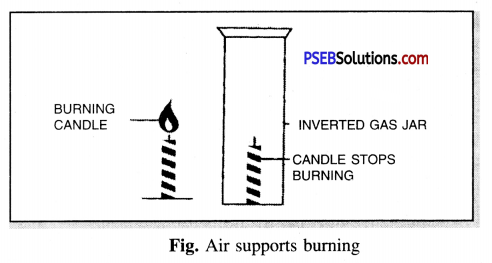
The candle is lighted by using a burning match stick. The candle will continue to bum in this case. This is because air is continuously available to the candle for its burning process.
Now cover the burning candle by putting an inverted jar over it. After a short time, the candle stops burning. It gets extinguished (see Figure). This can be explained as – when the burning candle is covered with glass jar, then the candle takes the oxygen necessary for burning from the air enclosed in gas jar. Since only a small amount of oxygen is available in the gas jar which is used in short time then the burning candle gets extinguished. Thus when a burning candle is covered with gas jar, then the fresh supply of air to the candle is cut off and hence it stops burning.
From this experiment, we conclude that air is necessary for burning.
Question (ii)
How is the balance of carbon dioxide and oxygen gases is maintained in the atmosphere ?
Answer:
Air contains both, oxygen gas and carbon dioxide gas. Plants use carbon dioxide of air and produce oxygen during photosynthesis. Oxygen is used by animals for respiration and carbon dioxide gas exhaled by them is produced which goes into the air and is used by plants. This is how the balance of carbon dioxide and oxygen gases is maintained in the atmosphere.
PSEB Solutions for Class 6 Science Air Around Us Important Questions and Answers
Multiple Choice Questions:
Question 1.
Which gas is needed for burning ?
(a) Oxygen
(b) Nitrogen
(c) Carbon dioxide
(d) All.
Answer:
(a) Oxygen
![]()
Question 2.
Oxygen and Nitrogen constitute , ……………… of air.
(a) 1%
(b) 99%
(c) 100%
(d) None.
Answer:
(b) 99%
Question 3.
The plants release ……………….. during photosynthesis.
(a) Oxygen
(b) Nitrogen
(c) Carbon dioxide
(d) None.
Answer:
(c) Carbon dioxide
Question 4.
Air is:
(a) A mixture of gases
(b) A compound
(c) An element
(d) None.
Answer:
(a) A mixture of gases
Question 5.
Oxygen in air is replaced by:
(a) Respiration
(b) Burning
(c) Photosynthesis
(d) None.
Answer:
(c) Photosynthesis
Question 6.
Air helps in moving:
(a) Yachts
(b) Parachutes
(c) Windmills
(d) All.
Answer:
(d) All.
Fill in the Blanks:
(a) The ………………… air sways the clothes on cloth line.
Answer:
moving
(b) Air ……………… space.
Answer:
occupies
(c) Our earth is …………….. by a thin layer of air.
Answer:
surrounded
![]()
(d) Air is a ………………. of many gases.
Answer:
mixture
(e) For burning ……………….. is needed.
Answer:
oxygen
(f) Suffocation is result of excess ……………….. in the room.
Answer:
carbon dioxide
(g) The burning of fuels ……………….. smoke.
Answer:
produce
(h) ……………………. particles are always present in the air.
Answer:
Dust
(i) Hair in nose ……………….. dust particles from getting into our body.
Answer:
prevent
(j) Air is present in the tiny …………………. of soil.
Answer:
particles
(k) The wind makes the ………………… rotate.
Answer:
wind-mill
![]()
(l) ………………… plays an important role in water cycle.
Answer:
Air
Write T against true and F against false statement:
(a) Air is found in soil only.
Answer:
False
(b) Air has no visibility but it is transparent.
Answer:
True
(c) Nitrogen is needed for burning.
Answer:
False
(d) Smoke disturbs birds in the sky.
Answer:
True
(e) We should breathe through open mouth.
Answer:
False
(f) Water has air in it.
Answer:
True
(g) Composition of air is constant everywhere.
Answer:
False
(h) Earthworms live in holes in the earth.
Answer:
True
(i) Plants consume oxygen for respiration.
Answer:
True
![]()
(j) Windmills generate electricity.
Answer:
True
Very Short Answer Type Questions
Question 1.
Where is air found ?
Answer:
All around us i.e. everywhere.
Question 2.
What makes the leaves rustle ?
Answer:
Air.
Question 3.
What is colour of air ?
Answer:
No colour/colourless.
Question 4.
Which gas is filled in cylinders carried by mountaineers ?
Answer:
Oxygen.
Question 5.
Presence of which particle is important for water cycle ?
Answer:
Water vapour.
Question 6.
Which gas is produced during burning/respiration ?
Answer:
Carbon dioxide.
Question 7.
From where do roots get oxygen for respiration ?
Answer:
Air present in soil.
![]()
Question 8.
What is layer of air around the earth known as ?
Answer:
Atmosphere.
Short Answer Type Questions
Question 1.
What is air ?
Answer:
Air is a mixture of gases such as oxygen, nitrogen, carbondioxide, water vapour, dust particles etc.
Question 2.
Why is oxygen important ?
Answer:
Oxygen is important because it is needed for burning and respiration.
Question 3.
How do animals living on soil and roots of plant respire ?
Answer:
Soil contains air in the space between its particles. Burrows of animals also allow air to circulate through these spaces. So this air is used by animals and roots for respiration.
Question 4.
List uses of air.
Answer:
Uses of air :
- It is used for rotating wind mills.
- It is used for moving yachts, gliders etc.
- It is used by brids for flying.
- It is used for burning.
- It is used for dispersal of seeds and pollen grains.
- It is used for respiration.
- It is used for winnowing.
Question 5.
Write few uses of wind mills.
Answer:
Wind mill is a set up which runs on moving air or wind. This is very useful for many activities.
Uses of wind mills :
- For drawing water from tube wells.
- For generating electricity.
- For running flour mills.
![]()
Long Answer Type Questions
Question 1.
How will you show that an empty glass bottle is filled with air ?
Or
How will you show that air occupies space ?
Answer:
Air occupies space. We take an empty glass bottle and hold it in the inverted position. The inverted glass bottle is put in water kept in a vessel (Fig. A). We will find that the water does not enter into the inverted glass bottle because the bottle is filled with air. Actually, all the space in the bottle is occupied by air. From this experiment we conclude that air occupies space.
If we tilt the bottle held in water we will find that the air present in the bottle goes out in the form of bubbles (Fig. B.)
As the air from the bottle escapes, water starts entering the glass bottle. Actually, the space vacated by the air leaving the bottle is now occupied by water.
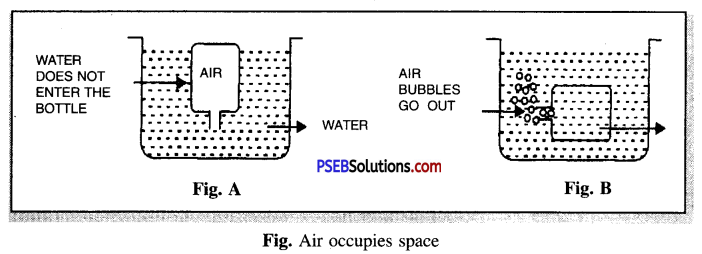
Question 2.
Give an experiment to show the presence of water vapours in the air.
Answer:
Experiment showing presence of water vapours in air. The presence of water vapours in the air can be shown as follows:
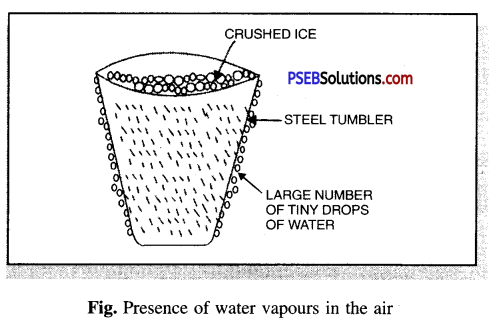
We take a steel or glass tumbler and put some well crushed ice into it. (See Fig.). Wipe the tumbler from outside with a piece of clean and dry cloth so as to make its outer surface completely dry.
Allow the ice-containing steel or glass tumbler to stand undisturbed for five minutes. A large number of tiny drops of water appear on the outer surface of steel tumbler. This is because the air around the steel tumbler contains water vapours in it. When they come in contact with cold, they condense to form tiny drops of liquid water.
Thus, by observing the formation of drops of water on the outside surface of the steel or the glass tumbler containing crushed ice we conclude that water vapours are present in air.
Question 3.
Besides water, what other thing is present in the lump of soil ? Show its presence.
Answer:
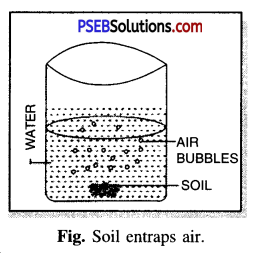
Air is also present in the lump of soil. It can be shown as follows :
We take the lump of soil and put it in a vessel full of water. We will see air bubbles escaping from the lump of soil into the water.
Actually the lump of soil contains air in its pores. When the lump of soil is put in water, the water displaces air from its pores. So, the air present in the lump of soil is seen going out in the form of air bubbles in the vessel containing
water.
Question 4.
How will you show that air contains dust particles ?
Answer:
The presence of dust particles in air can be shown as follows :
We darken a room completely by putting black chart papers on its windows and a black curtain on its door. A small hole is made in the black chart paper fixed on that window, which faces the sun. See Fig.
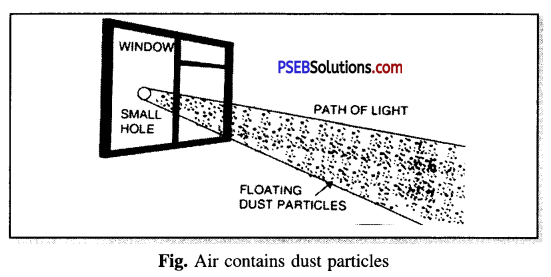
A thin beam of sunlight enters the darkened room through the small hole made in the window. We can see the small dust particles moving in the beam of light in the darkroom. Actually, the air in the room always contains some dust particles but they are so small that normally they are not visible to us. These tiny dust particles become visible and can be seen by us only when a thick beam of sunlight falls on them. This experiment shows that air contains dust particles.